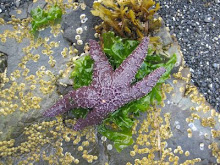Photo by Brad Chapman
This photo is of a breaching Humpback whale. While captaining a tour to view Sea Otters in Sitka Sound in Southeast Alaska, I spotted a whale breaching off in the distance. I slowed down and carefully entered the area and then came to a stop to wait for the whale to blow at the surface again. I grabbed my camera and stepped out of the pilot house. No sooner did I focus the camera on the area that the whale was last seen at, when the whale breached again, right next to our vessel. I whipped the camera up to my eye and snapped the shudder. Unfortunately, it took the camera a second to focus and instead of getting the whale in a vertical position, the shudder went off with the Humpback in a horizontal position. The crack as the whale hit the surface was very loud, and, the big splash startled the tourists on the viewing deck - they were not ready for such an explosive breach! I had never been so close to a breaching whale. I immediately felt the same reaction as when I was on hunting trips with my Dad and saw a large Bull Elk or a Coyote at close distance; hair standing straight up on the back of my neck and goose bumps. Large mammals have always mystified me. The amazing thing is that the ocean covers 3/4's of the earths surface - that makes seeing such a large creature up so close and in the wild truly a remarkable experience.
Male Humpbacks average 40 to 48 feet, with females ranging from 45 to 50 feet in length. They weigh anywhere from 25 to 40 tons. Their heads take up about one third of their body length and their most recognizable trait, their long flippers run from one quarter to one third the length of their bodies. They reach sexual maturity at age 6 to 8 years, with females giving birth every two to three years to calves weighing up to one ton and 10 to 15 feet long. Calves feed on mother's milk for a year before being weaned. This info is from www.worldwidewhale.com/humpbackfacts.php
As you look at the photo, you can see a couple of interesting things about the Humpback Whale:
Humpbacks have the longest pectoral fins of any whale. On a humpback they can be up to 6 feet in length. That is the reason that the latin name is Megaptera Novaeangliae, which means, "Winged New Englander". The photo provides a good look at the whale's ventral pleats. They are the lines running from the head to the tail end. When a humpback opens his mouth to gulp a big mass of fish, the pleats expand and allow the whale to gulp huge amounts of fish or plankton filled seawater. The whale then pushes the water out through the baleen plates leaving a nice mass of small fish or plankton to swallow.
Here is a photo of a pectoral fin. Humpbacks like to slap the surface with their pectoral fins.
Each fin can be up to 6 feet long. Do you notice the white striped areas on the pectoral fin? Those are teeth marks from Killer Whales. A group of Killer Whales tried to drown this Humpback by biting its pectoral fins and tail and holding it under the water until it drown. They weren't successful. One interesting thing though. Look at the next photo. Do you see anything odd about the this photo of the same humpback?
It is missing the tip of its pectoral fin. Probably from the same battle where he got the tooth scrapes in his pectoral fin. I never personally saw Killer Whales take a Humpback. But a friend of mine, Ray Majeski, from Sitka, Alaska told me that he once saw a group of Killer Whales drown and eat a baby Humpback. It sounds terrible, but those Killer Whales were just providing food for their family members.
From the tooth scars on the photo, we can see that that Humpback fought for his life and won. So goes His wonders of the deep.
Both the first picture of the whale breaching close to the boat and the second group of photos where the evidence shows that it just barely got away with his life.......were too close for comfort.
Here is a photo of Bryan and myself (1996) in the vessel I was in when I took the photos of the fin scarred whale. Bryan is about 3 years old in this photo. This vessel held 49 passengers and its top speed was 26 knots. (about 30 miles per hour)




























